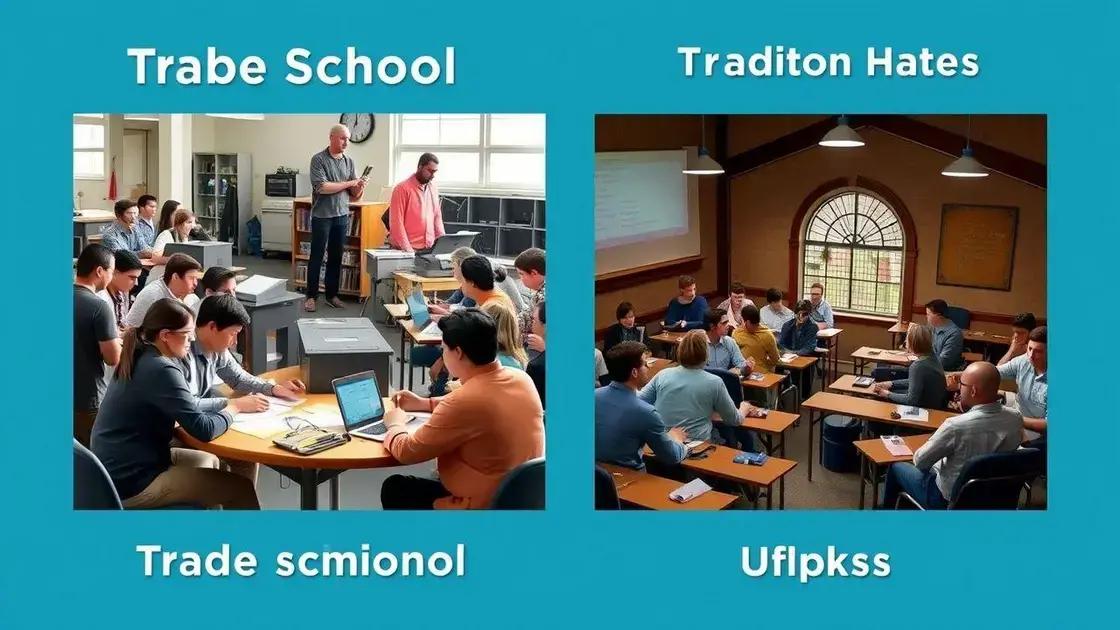Trade school enrollment increase: why now is the time to act

Anúncios
Trade school enrollment increases are driven by factors such as high demand for skilled labor, shorter program durations, hands-on training, and better job placement opportunities, making vocational education an attractive choice for students.
Trade school enrollment increase is more than just a statistic; it represents a shift in how individuals view education and career training. Have you ever wondered how this trend could impact your future? Let’s dive in and explore why more students are turning to trade schools.
Anúncios
Understanding trade schools and their offerings
Understanding what trade schools offer is crucial for anyone considering career options. Trade schools focus on specific skills and hands-on training, making them a popular choice for many students today.
These institutions prepare students for in-demand careers in various fields. Potential students often ask, “What exactly do trade schools provide?” Let’s clarify.
Anúncios
Programs Offered
Trade schools typically offer a diverse range of programs. Each program is designed to equip students with practical skills for the workforce.
- Electrical and plumbing training
- Automotive repair courses
- Healthcare and medical support education
- Culinary arts and hospitality programs
Another important aspect is the time frame for education. Many trade schools provide **short-term** programs, allowing students to enter the workforce quickly.
Quality of Education
The quality of training is another key feature of trade schools. Instructors often have extensive experience in their fields, ensuring students receive pertinent knowledge and skills.
Hands-on training is a significant part of the curriculum. This approach not only boosts confidence but also enhances job readiness.
Financial Considerations
For those concerned about cost, trade schools often have more affordable tuition compared to traditional colleges. This accessibility can be a major draw for students looking to minimize student debt.
- Flexible payment options
- Shorter program durations leading to savings
- Increased earning potential post-graduation
As we see, trade schools play a vital role in today’s education landscape. They offer specialized training that directly correlates with job opportunities, providing students with valuable skills for their careers. Understanding these offerings can help students make informed decisions about their futures.
Factors driving trade school enrollment increase
Several factors contribute to the noticing trend of trade school enrollment increase. More students are choosing vocational paths for various reasons, which directly impacts their career readiness and job opportunities.
One key reason is the rising demand for skilled workers in many industries. As employers look for specialized skills, trade schools equip students with the necessary tools and knowledge.
Market Demand
The job market is changing rapidly. Many sectors are experiencing significant growth, especially in technical and skilled labor fields. To address this demand, trade schools have adapted their curricula.
- Increased focus on STEM fields
- Hands-on experience with modern technologies
- Collaboration with local businesses for job placements
This alignment with the job market ensures that students are prepared for roles that employers are eager to fill.
Cost-Effectiveness
Another important factor driving enrollment is the affordability of trade schools. Compared to traditional colleges, these institutions often offer a more economical option.
- Shorter program lengths leading to quicker employment
- Lower tuition fees compared to four-year colleges
- Potential for less student debt
These financial considerations make trade schools an attractive choice for many students. It’s also worth noting that with a trade, graduates often find themselves with a higher earning potential right after completing their education.
Moreover, the perception of trade jobs is changing. Many people now recognize that skilled labor is essential and rewarding. As a result, there is a growing appreciation for vocational education.
Networking and mentorship opportunities within trade schools also support students after they graduate. These connections can lead to job offers and career advancement, further boosting interest in enrollment.
Benefits of enrolling in a trade school
Enrolling in a trade school can provide numerous advantages for students looking to enhance their skills and career prospects. Many individuals are turning to vocational education because of the clear benefits it offers.
One of the major advantages is the focus on practical skills. Trade schools are designed to give students hands-on experience, allowing them to learn through real-world applications.
Specialized Training
Trade schools offer specialized training in various fields. This focused education enables students to master specific skills that are highly sought after in today’s job market.
- Programs tailored to industry requirements
- Instructors with substantial real-world experience
- Access to modern tools and equipment
This method prepares students not just for jobs but for careers, making them valuable employees right from the start. Understanding the job demands helps ensure students’ skills stay relevant.
Shorter Education Duration
Another significant benefit of trade schools is the shorter duration of programs compared to traditional colleges. Students can often complete their training in one to two years.
- Quick entry into the workforce
- Reduced overall education costs
- Less student loan debt
This rapid path to employment is appealing to many, especially those eager to start their careers as soon as possible. Many trade school graduates find jobs right after completing their programs.
Additionally, trade schools often have strong connections with local employers, which can greatly assist students in finding job placements. These partnerships mean that students have direct pathways to employment.
Finally, many trade school graduates enjoy higher job satisfaction. Focusing on skills they love can lead to fulfilling careers, enhancing their overall quality of life. By choosing to enroll in a trade school, students take a proactive step toward their futures.
How trade schools compare to traditional colleges

Understanding how trade schools compare to traditional colleges can help students make informed decisions about their education. Both options offer unique advantages, but they cater to different career paths and learning styles.
Trade schools focus on practical skills and hands-on training. In contrast, traditional colleges often provide a broader education with a focus on theory and general knowledge.
Curriculum Differences
The curriculum at trade schools is typically designed to teach specific skills required for certain jobs. Students often engage in lab work and internships, which allows them to gain real-world experience.
- Hands-on training in specialized fields
- Shorter program durations, usually 1-2 years
- Direct job placement services often included
In contrast, traditional colleges may require students to complete general education courses before focusing on their major. This approach can take longer and often leads to a four-year degree.
Cost and Time Commitment
Another significant difference is the cost and time involved. Trade schools often have lower tuition fees compared to traditional colleges. The shorter duration of programs also means students start working sooner.
- Lower overall student debt
- Faster entry into the workforce
- Ability to earn and pay off loans quickly
This financial benefit appeals to many students, especially those who are concerned about accumulating debt. In many cases, trade school graduates can earn competitive salaries shortly after entering their field.
Job security is another consideration. Many technical and skilled labor roles have a high demand for workers, and trade schools prepare students for these in-demand positions. Traditional colleges may offer more diverse career options, but the job market can be unpredictable at times.
Challenges faced during trade school enrollment
Many students encounter challenges when considering trade school enrollment. Being aware of these obstacles can help prospective students prepare and make informed decisions.
One common challenge is navigating the application process. The requirements can vary significantly between institutions, which may cause confusion for applicants.
Understanding Financial Aid
Understanding financial aid options is crucial for many students. Applying for scholarships, grants, and loans can be overwhelming, especially if students are unfamiliar with the terms.
- Many students miss deadlines for financial aid applications.
- Inadequate guidance on available scholarships and grants.
- Fear of incurring significant student debt.
These financial concerns can deter students from enrolling in trade schools, even when the potential benefits outweigh the costs.
Finding the Right Program
Another challenge is selecting the right program. With so many options available, it can be difficult for students to decide which field to pursue.
- Lack of information about various trade careers.
- Pressure from family and peers to follow a particular path.
- Uncertainty about job security in chosen fields.
This uncertainty can lead to hesitation in committing to a specific program. Prospective students may feel overwhelmed by the responsibility of choosing a career that aligns with their interests and market demand.
Additionally, students may face external pressures from family expectations or societal norms regarding education. Some individuals may feel that attending a traditional college is a more accepted path, which can lead to self-doubt.
Success stories of trade school graduates
Success stories of trade school graduates highlight the real-world impact of vocational education. Many individuals have transformed their lives by choosing trade schools for their career paths.
One notable success story is that of a young woman who enrolled in a culinary program. After completing her training, she opened her own restaurant and is now a well-respected chef in her community. Her story showcases how practical skills learned at trade school can lead to fulfilling careers.
Real-Life Examples
Another example is a graduate from an automotive technology program. He began working as a mechanic shortly after graduation and quickly moved up to a supervisory position. This success demonstrates that trade schools not only provide the necessary skills but also introduce students to job opportunities that can lead to advancement.
- Graduates often report high job satisfaction rates.
- Many find stable and well-paying jobs in their chosen fields.
- Success often comes from the connections made during training.
Additionally, a graduate from an electrician program shared her journey of starting her own contracting business. Through hard work and dedication, she has built a successful company and now employs others, demonstrating how trade school can empower individuals and contribute to local economies.
Impact on Communities
These stories are not only about personal achievement but also reflect the positive impact on communities. Graduates typically fill important roles that are vital for economic stability. When trade school graduates succeed, they contribute to the overall strength of the workforce.
Moreover, the connections formed in trade schools can lead to lifelong friendships and professional networks. Many graduates stay in touch, providing support and opportunities for one another in their careers.
Future trends in vocational education
The future of vocational education looks promising, with several trends shaping how students prepare for their careers. As the job market evolves, trade schools are adapting to meet the needs of both students and employers.
One significant trend is the integration of technology into vocational training. Many trade schools are now including courses on emerging technologies to ensure students are well-equipped for modern jobs.
Incorporating Digital Skills
Digital skills are in high demand across various industries. Trade schools are now offering programs that focus on technology, such as coding, digital marketing, and software development.
- Courses that teach data analysis and management.
- Programs that integrate virtual reality for hands-on training.
- Online courses and hybrid models to increase accessibility.
This focus on digital skills allows students to compete in an increasingly tech-driven job market.
Collaboration with Industry
Another trend is the growing collaboration between trade schools and local industries. Many vocational programs are partnering with businesses to develop curricula that align with current job requirements.
- Internships and apprenticeships provide real-world experience.
- Businesses help shape the skills taught in programs.
- Employers often participate in recruitment events at schools.
This collaboration not only enhances the education students receive but also improves job placement rates after graduation.
Additionally, there is an increasing emphasis on lifelong learning. As technology continues to change, workers will need to upskill or reskill to stay relevant. Trade schools are beginning to offer continuing education programs to help professionals advance their careers.
With these trends, vocational education is becoming a vital part of workforce development. Students are more prepared than ever to enter the workforce, and the demand for skilled labor is likely to grow.
How to choose the right trade school

Choosing the right trade school is an important decision for those looking to enter skilled professions. It can greatly impact your future job opportunities and personal satisfaction.
One of the first steps in making this choice is to research various schools and their programs. Look for institutions that offer the specific training you are interested in.
Key Factors to Consider
When evaluating trade schools, consider several key factors that can influence your decision.
- Accreditation: Ensure the school is accredited and recognized by relevant industry organizations.
- Program Curriculum: Review the curriculum to see if it covers essential skills and current industry practices.
- Hands-on Training: Look for schools that offer practical experience through internships and labs.
- Job Placement Services: Check if the school provides assistance finding jobs after graduation.
These factors are crucial in determining whether a trade school will meet your professional needs and help you succeed.
Visiting Schools
Visiting prospective trade schools can provide valuable insights. During a visit, ask questions about the program, instructors, and resources available to students.
Consider taking a tour of the facilities. This allows you to see the equipment and resources you will use during your training. Speaking directly with current students can also give you a clearer picture of the school culture and learning environment.
Additionally, check online reviews and ratings. Feedback from former students can provide context about their experiences and the school’s effectiveness in helping graduates succeed in their careers.
Another key aspect is understanding the financial commitments involved. Review the tuition, fees, and available financial aid options. Knowing your financing options early will help you make an informed decision.
In conclusion, trade schools offer a valuable pathway for students looking to gain specialized skills and quickly enter the workforce. With a growing demand for skilled labor, choosing the right trade school becomes essential. Researching various programs, visiting campuses, and understanding financial options can greatly enhance your decision-making process. Successful graduates serve as inspiration, showcasing how vocational education can lead to fulfilling careers. By considering these factors, you can make an informed choice that aligns with your future goals.
FAQ – Frequently Asked Questions about Trade School Enrollment
What factors should I consider when choosing a trade school?
When selecting a trade school, consider accreditation, program curriculum, hands-on training opportunities, and job placement services.
How can I find financial aid for trade school?
Explore scholarships, grants, and loan options available to students. Most trade schools provide assistance in navigating financial aid.
Are trade schools worth the investment?
Yes, trade schools often have lower tuition costs and shorter programs, allowing students to enter the workforce quickly with valuable skills.
What types of programs are offered at trade schools?
Trade schools offer a variety of specialized programs, including automotive technology, culinary arts, healthcare, and skilled trades like plumbing and electrical work.






